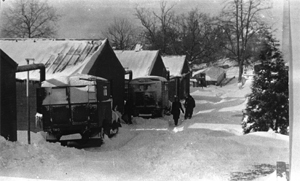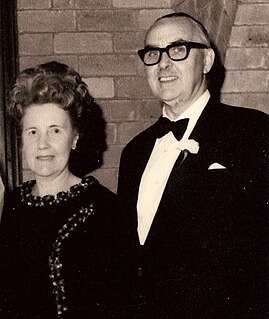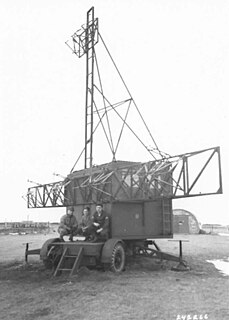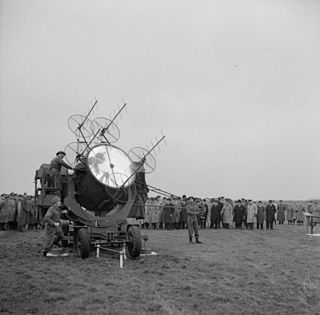Related Research Articles
The Royal Radar Establishment was a research centre in Malvern, Worcestershire in the United Kingdom. It was formed in 1953 as the Radar Research Establishment by the merger of the Air Ministry's Telecommunications Research Establishment (TRE) and the British Army's Radar Research and Development Establishment (RRDE). It was given its new name after a visit by Queen Elizabeth II in 1957. Both names were abbreviated to RRE. In 1976 the Signals Research and Development Establishment (SRDE), involved in communications research, joined the RRE to form the Royal Signals and Radar Establishment (RSRE).
The Royal Signals and Radar Establishment (RSRE) was a scientific research establishment within the Ministry of Defence (MoD) of the United Kingdom. It was located primarily at Malvern in Worcestershire, England. The RSRE motto was Ubique Sentio.

The Telecommunications Research Establishment (TRE) was the main United Kingdom research and development organization for radio navigation, radar, infra-red detection for heat seeking missiles, and related work for the Royal Air Force (RAF) during World War II and the years that followed. It was regarded as "the most brilliant and successful of the English wartime research establishments" under "Rowe, who saw more of the English scientific choices between 1935 and 1945 than any single man."
The Ministry of Supply (MoS) was a department of the UK government formed in 1939 to co-ordinate the supply of equipment to all three British armed forces, headed by the Minister of Supply. A separate ministry, however, was responsible for aircraft production, and the Admiralty retained responsibilities for supplying the Royal Navy. During the war years the MoS was based at Shell Mex House in The Strand, London.
The Signals Research and Development Establishment (SRDE) was a British government military research establishment, based in Christchurch, Dorset from 1943 until it merged with the Royal Radar Establishment (RRE) in Malvern, Worcestershire to form the Royal Signals and Radar Establishment (RSRE) in 1976. Its focus was military communications (signals).
Christchurch Airfield was located southeast of the A337/B3059 intersection in Somerford, Christchurch, Dorset, England.
The Aerial Delivery Research and Development Establishment (ADRDE) is a laboratory of the Indian Defence Research and Development Organisation (DRDO). It is located in Agra, Uttar Pradesh in India. Its research scope includes development of systems for dropping heavy loads, brake parachutes, towed targets, aircraft arrester barriers and aerostats.

William Alan Stewart Butement was a New Zealand-born British-Australian defence scientist and public servant. A native of New Zealand, he made extensive contributions to radar development in Great Britain during World War II, served as the first chief scientist for the Australian Defence Scientific Service, then ended his professional career with a research position in private business.
Radar in World War II greatly influenced many important aspects of the conflict. This revolutionary new technology of radio-based detection and tracking was used by both the Allies and Axis powers in World War II, which had evolved independently in a number of nations during the mid 1930s. At the outbreak of war in September 1939, both Great Britain and Germany had functioning radar systems. In Great Britain, it was called RDF, Range and Direction Finding, while in Germany the name Funkmeß (radio-measuring) was used, with apparatuses called Funkmessgerät . By the time of the Battle of Britain in mid-1940, the Royal Air Force (RAF) had fully integrated RDF as part of the national air defence.
Sir George Gray Macfarlane was a British engineer, scientific administrator and public servant.

James Stanley Hey was an English physicist and radio astronomer. With the targeted application of radar technology for astronomical research, he laid the basis for the development of radio astronomy. While working in Richmond Park during the Second World War, He discovered that the Sun radiates radio waves and localised for the first time an extragalactic radio source in the constellation Cygnus.

Radar, Gun Laying, Mark I, or GL Mk. I for short, was an early radar system developed by the British Army to provide range information to associated anti-aircraft artillery. There were two upgrades to the same basic system, GL/EF and GL Mk. II, both of which added the ability to accurately determine bearing and elevation.

Radar, Anti-Aircraft Number 3 Mark 7, also widely referred to by its development rainbow code Blue Cedar, was a mobile anti-aircraft gun laying radar designed by British Thomson-Houston (BTH) in the mid-1940s. It was used extensively by the British Army and was exported to countries such as Holland, Switzerland, Sweden Finland and South Africa. In British service, it was used with the 5.25 inch and QF 3.7 inch AA guns, as well as the Brakemine missile.

Radar, Gun Laying, Mark III, or GL Mk. III for short, was a radar system used by the British Army to directly guide, or lay, anti-aircraft artillery (AA). The GL Mk. III was not a single radar, but a family of related designs that saw constant improvement during and after World War II. These were renamed shortly after their introduction in late 1942, becoming the Radar, AA, No. 3, and often paired with an early warning radar, the AA No. 4, which was also produced in several models.

John Robert Mills was a British physicist and scientific expert who played an important role in the development of Radar and the defence of Britain in World War II. After the war he continued his career working for various British government research establishments on a variety of projects until his retirement in 1977.

Searchlight Control, SLC for short but nicknamed "Elsie", was a British Army VHF-band radar system that provided aiming guidance to an attached searchlight. By combining a searchlight with a radar, the radar did not have to be particularly accurate, it only had to be good enough to get the searchlight beam on the target. Once the target was lit, normal optical instruments could be used to guide the associated anti-aircraft artillery. This allowed the radar to be much smaller, simpler and less expensive than a system with enough accuracy to directly aim the guns, like the large and complex GL Mk. II radar. In 1943 the system was officially designated Radar, AA, No. 2, although this name is rarely used.
The Air Defence Experimental Establishment (ADEE) was a civil agency run by the British War Office, the civilian side of the British Army. It was primarily tasked with developing sound ranging of enemy artillery, and the development of anti-aircraft weapons and techniques, notably searchlights.
The Radar Research and Development Establishment, RRDE for short, was a civilian research organization run by the United Kingdom's Ministry of Supply that primarily studied the development of radar for British Army use.

The AMES Type 82, also widely known by its rainbow codename Orange Yeoman, was an S-band 3D radar built by Marconi and used by the Royal Air Force (RAF), initially for tactical control and later for air traffic control (ATC).

Ronald Hugh Barker FIEE was an Irish physicist and inventor of Barker code for digital synchronisation. He was a member of the Institution of Engineering and Technology (IET) for 70 years. Born in Dublin, Ireland, Barker excelled in mathematics, becoming keen on electronics. He is best known for his ground-breaking work on synchronising digital communication systems and framing of received data, using digital codes. These digital codes are known as Barker code. The method was initially researched at SRDE Royal Signals Research Establishment, just after World War II for use in radar, rocket telemetry and digital speech. In 1952, Barker found 7 Barker sequences up to a length of 13 useful for correlation. These sequences are widely used in most data transmissions today. Examples of applications are radar, mobile phone technology, telemetry, digital speech, ultrasound imaging and testing, GPS and Wi-Fi, etc.
References
- "Air Defence Research and Development Establishment". The National Archives.
- Howse, Derek (1993). Radar at Sea: The Royal Navy in World War 2. Springer. p. 33. ISBN 9781349130603.